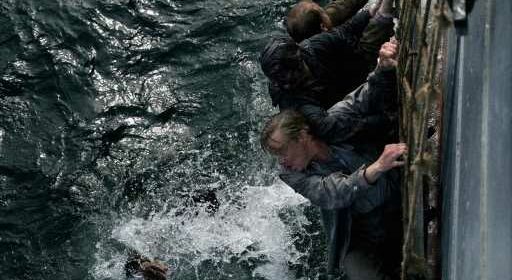‘War Sailor’ Review: Gunnar Vikene’s Norwegian Oscar Entry

From Bergen to Malta, Liverpool, New York and Halifax: Norwegian merchant seamen Alfred (Kristoffer Joner) and Sigbjorn (Pal Sverre Hagen) sometimes seem to be competing for screen time with datelines in Gunnar Vikene’s epic War Sailor, Norway’s Oscar submission. Sprawling, packed with anecdote and surging from one dramatic peak to the next, War Sailor sets out to tell the stories of the ordinary but unsung heroes who helped defeat Germany in 1945. It has the best of intentions.
Perhaps if it had focused on fewer of those horror stories and cut that plot in half, it might not have also felt quite so much like a whistle-stop tour. As it is, director Gunnar Vikene takes us speeding through death, injuries and emotional trauma, the difficulties of post-war peace and onward to the farthest reaches of post-war PTSD, three decades later. As a conscientious guide, he is determined we won’t miss a thing.
Related Story
2022-23 Awards Season Calendar – Dates For The Oscars, Golden Globes, Guilds & More
The starting point is Bergen in 1939, where dockyard day laborer Alfred is struggling to support his wife Cecilia (Ine Marie Wilmann) and their three children on his patchy wages. Reluctantly, he signs on to the merchant navy with his lifelong friend Sigbjorn, whose parting promise to Cecilia is that he will bring Freddy home alive. After eight months at sea, they are told their country is now at war. Nobody will go home until it is over. “Norwegian ships supply half of what Britain needs to win this war,” booms the Captain (Nils Ove Sorvik) from the bridge. “They need us. They have children too.”
Thus the tone is set for a series of sea-going catastrophes and human dramas in which Alfred repeatedly shows his moral mettle. Men go overboard and are left behind because a coal-fired ship can’t stop safely; a tearful boy of 14 is dragged from the sea; their ship takes a hit from a German submarine; Alfred and Sigbjorn are seen drifting on a raft in the middle of the ocean, guarding the young boy’s corpse and sure they are going to die.
Frequent cuts and more interstitials take us back repeatedly to the home front. Plucky Cecilia has resorted to delivering firewood in occupied Bergen, dodging eviction and huddling with other families in cellars as the Allied bombs rain overhead. She never sees her husband’s wages. Nor does she see the letters he writes whenever there is a quiet moment, filing them away against a future that may never come.
When it does come, Alfred is not the same man. The family is not reunited until years after the war, Alfred having melted into the opium dens of the Far East after hearing that Bergen had been bombed to blazes. Rescued by Sigbjorn, he finds himself not only unpaid and unrecognized by the Norwegian authorities, but branded a deserter. This is essentially reportage; the treatment of civilian ancillary workers after the war remains a scandal. Lacerated by war, betrayal, dissipation and humiliation, hollowed out by suffering and anger, Alfred is still a shell of his brave young self in 1972, the last stop on the narrative’s line.
War Sailor is Norway’s most expensive film, a vauntingly ambitious labor of love for the director. Alfred, whose sense of decency and duty is the spreading narrative’s central upright, was directly based on a real person whom Vikene met years earlier and never forgot. Clearly, Vikene has spent years collecting these untold stories of terror and courage. Discarding any of them must have seemed unthinkable.
It would probably be impossible to wear so much knowledge lightly, but War Sailor staggers under the weight of so much detail and the spinning revolve of so much event, which requires some potentially key scenes to be compacted into a few lines and a telling reaction shot before moving right along. So many emotional crests bring War Sailor perilously close to melodrama; it is saved at several such brinks by the Nordic restraint of the performances, which are universally generous, sensitive and committed.
Cinematographer Sturla Brandth Grovlen — who also shot Oscar-winner Another Round — shows a similar commitment and scope, particularly in scenes shot in the sea, Vikene having ruled out using a water tank in order to achieve the documentary verisimilitude he wanted. A groaning string score by Volker Bertelmann shows further careful thinking. Everyone, in short, has given their all, only to skim the surface of this saga. As the credits roll, there is a sad sense that a little less could have been so much more.
Must Read Stories
‘Avatar: The Way Of Water’ Heading To $400 Million Worldwide Debut
Cecily Strong Says Farewell, Gets “Blue Christmas” Serenade From Austin Butler In Last Show
Paradigm Shift Puts Amazon Behind A Netflix Smash As Renewal Talks Begin
‘Till’ Director Chinonye Chukwu & The Power Of Fellini’s ‘8 1/2’
Read More About:
Source: Read Full Article



